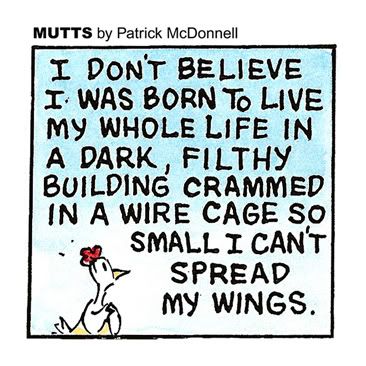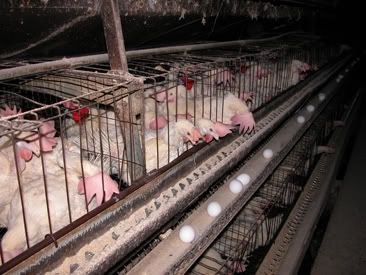If you’re looking for a thorough review of Prop 2, this is the place. Daniel Brezenoff, Dennis Smith and Pet Post writers Kate Karp and Judy Crumpton have offered their thoughts on this issue.
Daniel Brezenoff
What it does: Strengthens standards for confining farm animals. Mandates that livestock are given living conditions slightly better than they now have, but still slightly worse than Camarillo State Psychiatric Hospital.
Pros: Animals feel pain. They don’t deserve to be tortured before being eaten (and tortured animals produce tough, gamey meat anyway.)
Cons: Gives the idea that something besides profit and convenience should matter to the American consumer and big agribusiness. What stupid hippy thought this up?
How I’m voting: YES.
It’s about time. I hear the argument that agribusiness will flee California if this passes. Yeah – for where, exactly? The green valleys and lush fields of Western Nevada? No – no one can afford to ignore California’s markets or our breadbasket farmlands. We set the pace for progress, and as long as we are going to treat animals like meat-making machines, we need to do so with as little cruelty and neglect as human(e)ly possible. Besides, if we argue for cruelty because it (supposedly) protects jobs, markets, and prices, we might as well make the same argument about housing human prisoners or euthanizing dogs. Why bother with medical care at our jails? Jut pile up the convicts under a tarp and say, “It’s better than Andersenville”. Why bother with painless injections for disposing of unwanted pe(s)ts? Just kill them in the fastest, cheapest way possible – because it saves money. And let’s do away with all environmental and labor standards, while we’re at it – after all, they prevent multinational corporations from exploiting us and our ecology as easily they could in, say, Bangladesh or Guatemala, which are sure to economically surpass California any day now if we stop brutalizing baby cows!
No, the race to the (ethical) bottom is one race California should be proud to lose.
Will it pass? If we still have a heart.
Trivia: Bacon is gross, but yummy.
*
Dennis Smith
Prop 2: Standards for confining farm animals. Initiative statute. Tries to make all of our state’s livestock and farm animal free range, let them stretch and run round some. In other words create another layer of bureaucracy for the farmers. My vote is No on Prop 2.
*
Kate Karp and Judy Crumtpon
Prop 2 and Humane Treatment of Farm Animals: The Udder-dacity of Hope
Which came first, the chicken or the egg? We don’t give a hoot or a cluck, as long as they’re both free-range.
When two high-profile TV shows and one syndicated comic strip give airtime and support to a controversial proposition designed to prevent cruelty to farm animals, you know that the legislation isn’t a pile of cow pie created by fanatics.

Mutts ©2008 Patrick McDonnell, Distributed by King Features Syndicate Inc.
Mutts cartoonist Patrick McDonnell has his spokescritters saying YESH, as Mooch the cat pronounces it, to Prop 2, and McDonnell lives on the other coast, in New Jersey. Oprah Winfrey devoted her entire hour-long show to the proposition, and the program was well researched, informative and extraordinarily balanced, considering that the viewer could pretty well figure out whose side she was on, particularly after she quoted Gandhi. The show featured tours of both cage-free and factory farms and guests included Wayne Pacelle, president and CEO of the Humane Society of the United States (HSUS), who supports Prop 2, and Ryan Armstrong, a California egg farmer, who does not. Ellen DeGeneres also hosted Pacelle; she refused to show any of the photographs depicting the horrible conditions and treatment of pigs, chickens and cows in factory farms, stating that she had a happy show and the photos were not happy.
We try to be a happy column, but there are a lot of things that make us very unhappy when it comes to inhumane treatment of animals. DeGeneres instructed viewers to visit her Web site and click on the links to see the photos that she wouldn’t show. The couple that we’ve included are comparatively mild, so force yourself to watch the YES ads on television and visit the sites below to see other pictures to see for yourself how ugly it all is.
Proposition 2, the Prevention of Farm Animal Cruelty Act, protects air and water resources, safeguards the environment by ensuring less animal waste for pollution of air and water, mitigates greenhouse gas emissions, helps family farmers, improves health and food safety and, of course, ensures humane treatment to farm animals. We spoke with Michael Markarian, HSUS executive vice president, external affairs, who gave us a history of the proposition’s development and its effects not only on the animals but also on human health, if you happen to eat them. Markarian said that there has been a growing trend in U.S. corporations and public policy to grant humane treatment to animals. Florida and Arizona have passed ballot initiatives, and Oregon and Colorado passed measure in the legislation. The measures all deal with different types of confinement and cost, but they all lead in the same direction.
“Just because an animal is used for food doesn’t mean that we should treat animals cruelly before they’re killed,” Markarian said. “More people have the right instincts about animals now. Whether carnivore or vegetarian, we know that animals need better treatment, and Proposition 2 is the opportunity to do this.”
Factory farms—or agribusiness, as Markarian calls it—warehouses animals and treats them as objects even before they are slaughtered and no longer have life or feeling in them. The farmer hasn’t lived in the dell for decades. “In the 1960s, the farming model really shifted,” Markarian said. “Before that, farmers knew the animals and could feed them locally. Now, industrial animals are no longer treated as animals. The factory farmers are cutting corners to squeeze a profit, and animal welfare, public health and safety, and the environment all suffer.”

Chickens in battery cages can’t spread their wings, move or turn around. Photo courtesy of HSUS
Like Satan’s demons, instances of factory farm-born animal cruelty are legion. Judy discovered this firsthand in a humane education seminar when she learned about the Guantanamo Bay of factory farming: battery cages. To bring home the cruel effects of the cages, students were asked to stand barefoot on a wire replica of a cage floor. Judy lasted a handful of seconds, and none of the other students lasted more than five minutes. Chickens have to stand in the cages all their lives, and a podiatrist couldn’t correct what it does to their feet. Each cage is the size of a filing cabinet drawer, each side measuring 67 square inches. The hens’ beaks are often cut off to prevent them from pecking each other to death. They can’t turn around or spread their wings. All the cages are stacked one on top of the other, the hens on the top row may be white, but get browner and browner until they reach the bottom row where the birds are caked with feces.
And then some of you eat them and feed them to your families.
Veal calves are taken from their mothers when they are still nursing and stuck in wooden crates, tethered by the necks to the slats and growing weak and anemic. They are slaughtered as young as 4 months old. Breeding pigs are given gestation crates that are two feet wide, allowing absolutely no mobility. They can’t even lie down. Stress makes them bite the metal bars.
Imagine your own dog, cat, rabbit, bird, rodent or whoever shares your home in any of these conditions. They’re animals, too. Sometimes, we forget.
If you still think of a pig as a rack of ribs with legs, that’s a personal choice, and this legislation is not intended as vegetarian proselytizing. But as you reach into a bucket of fried chicken and get ready to sink your choppers into the thick coating of batter, remember the thick coat of something else that covers the live chickens. This is a health issue. According to Markarian, birds in cages are 10 times more likely to get salmonella than free-range chickens. And it’s not only a question of chickens and eggs either. You may recall the recent school lunch scandal in which “downed cows”—cows too sick or weak to walk and whose meat is tainted—were shocked, drugged and dragged to the slaughterhouse in pain and then fed to schoolchildren at noon. Moreover, with all the confinement in factory farm, animals are more likely to contract diseases of the intestines and urinary tract, leg and joint damage, and stress that releases hormones. Meet your meal.
“If [the proposition is] better for the animals, it’s better for us,” Markarian said.
And cost? What’s in your wallet and portfolio can directly affect your health. Oprah and Ellen and Patrick McDonnell no doubt can afford the price of free-range poultry and eggs. We’re nowhere near as solvent as they are, but we’re willing to sacrifice the extra dollar or two for free-range eggs. But we have no illusions that everyone is so willing, even if they support humane treatment of animals and healthy food. People tend to vote their pocketbooks, particularly these days.
There are two ways that Prop 2, according to the opponents, could affect cost: one to the consumers, and the other to state revenue. Opponents of the law believe that costs will shoot up because of the extra work and mateirals it will take to produce eggs, veal, poultry and pork. Markarian disagrees.
“The opposition has a scare campaign going on, and we don’t buy it,” he said. “The farmers can adapt. There’s a long phase-out time—until 2015. If they’re charging more now [for free-range products], it’s because they’re a specialty item. The actual labor cost for free-range eggs is one cent per egg—pennies. This comes out to about $2.50 a year. Isn’t it worth a couple of bucks to make food safer and the environment less polluted?”
Markarian also dismisses the claims that farmers will move out of state and California will be getting its eggs from Mexico if Prop 2 passes. He states similar cases: after Arizona banned gestation crates for pigs, Smithfield Foods, the nation’s largest pork producer, announced a national gradual termination of gestation-crate use. A week later, Canada’s largest pig producer also announced that it would stop its own pork-barrel spending. Many California farmers are already raising unconfined laying hens; Markarian further cited UC Davis Professor Dan Sumner as rejecting the claim that eggs would have to be imported from Mexico because the country doesn’t produce much feed corn.
The phase-out period built into Prop 2 is long enough to get it going right. There’s bound to be some initial cost and shake-up, just as there is when any major change for the better is implemented—take the auto industry, for example. But the results will be environmental improvement, safer foods for human health, and chickens, pigs and veal calves being able to stretch, turn around and lie down. And for that last result alone, it’s worth a few extra pennies.
“Think occasionally of the suffering of which you spare yourself the sight.”
– Albert Schweitzer
Vote YES on Prop 2
Humane Society of the United States
Mutts Comics
Ellen DeGeneres
Oprah!
The lbpost.com does not make political endorsements. However, as elections for officials and measures draw nearer, our writers/posters are free to endorse or support political candidates if they wish. In the coming weeks, you will notice endorsements from our writers concerning all levels of government. These are their opinions and words. Individual endorsements do not express the opinion of the other writers and/or the founders and staff of the lbpost.com.
